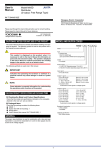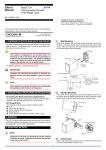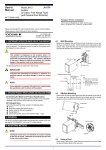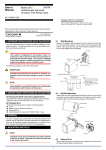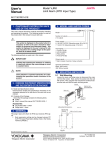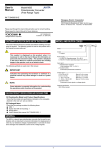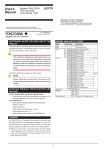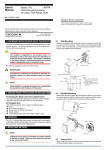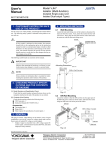Download User`s Manual
Transcript
User’s Manual Model MXD Universal Computing Unit (1-input, Isolated 1-output Type) <with Contact I/O> IM 77J04X12-01E Network Solutions Business Division 2-9-32, Naka-cho Musashino-shi, Tokyo 180-8750 Japan Phone: +81-422-52-7179 Facsimile: +81-422-52-6793 Please read through this User’s Manual before use for correct handling. Please keep this User’s Manual for future reference. IM 77J04X12-01E 1st Edition Aug. 2005 (YK) CAUTIONARY NOTES FOR SAFE USE OF THE PRODUCT This User’s Manual should be carefully read before installing and operating the product. The following symbol is used on the product and in this manual to ensure safe use. This symbol is displayed on the product when it is necessary to refer to the User’s Manual for information on personnel and instrument safety. This symbol is displayed in the User’s Manual to indicate precautions for avoiding danger to the operator, such as an electric shock. The following symbols are used only in this manual. IMPORTANT Indicates that operating the hardware or software in a particular manner may cause damage or result in a system failure. NOTE Draws attention to essential information for understanding the operations and/or functions of the product. CHECKING PRODUCT SPECIFICATIONS AND PACKAGED ITEMS (1) Checking the Model and Product Specifications Check that the model and specifications indicated on the nameplate attached to the main unit are as ordered. (2) Packaged Items Check that the package contains the following items: ● MXD: 1 ● Range label: 1 ● Spacer: 1 ● Receiving resistor (for current input): 1 ● User’s Manual (this manual: IM 77J04X12-01E): 1 * When the optional specification “/R250” is specified, the 250 Ω receiving resistor is attached. When the optional specification “/R250” is not specified, the 100 Ω receiving resistor is attached. GENERAL This plug-in type universal computing unit receives DC current or DC voltage signals, applies various computing functions to them, and then converts them into isolated DC current or DC voltage signals. MODEL AND SUFFIX CODES MXD- N- *B/ Model Function A: Free program L: Analog memory M: Peak holder N: Bottom holder P: Program setter (Note 1) Q: Integrated pulse output Input signal A: 0 to 50 mA DC Span is 1 mA or more B: 0 to 10 mA DC Span is 0.1 mA or more 1: −10 to +10 V DC Span is 0.1 V or more 2: − 2 to + 2 V DC Span is 10 mV or more N: No analog input (Note 1) Output signal A: 0 to 20 mA DC B: 0 to 5 mA DC 1: 0 to 10 V DC 2: 0 to 100 mV DC 3: −10 to +10 V DC 4: −100 to +100 mV DC Span is 2 mA or more Span is 1 mA or more Span is 0.1 V or more Span is 10 mV or more Span is 0.2 V or more Span is 20 mV or more Power supply 1: 15-40 V DC (Operating range: 12 to 48 V DC) 2: 100-240 V AC (Operating range: 85 to 264 V AC) Optional specification /R250: With 250 Ω receiving resistor Note 1: The input signal suffix code “N” is fixed when the program setter is selected. However, the analog input is adjusted and inspected by 1 to 5 V DC of the input signal suffix code “1” before shipment. 1. MOUNTING METHOD 2. INSTALLATION LOCATIONS ● Avoid the following environments for installation locations: Areas with vibration, corrosive gases, dust, water, oil, solvents, direct sunlight, radiation, a strong electric field, and/or a strong magnetic field Installation altitude: 2000 m or less above sea level. ● If there is any risk of a surge being induced into the power line and/or signal lines due to lightning or other factors, a dedicated lightning arrester should be used as protection for both this computing unit and a field-installed device. ● Operating temperature/humidity range: 0 to 50C/5 to 90%RH (no condensation) NOTE Plug/disconnect the main unit into/from the socket vertically to the socket face. Otherwise the terminals may bend and it may cause bad contact. 1.1 Wall Mounting Unfasten the upper and lower stoppers of the computing unit to disconnect the main unit from the socket. Next, anchor the socket onto the wall with two M4 screws. Then, plug the main unit into the socket and secure the main unit with the upper and lower stoppers. 3. EXTERNAL WIRING Stopper WARNING To avoid the risk of an electric shock, turn off the power supply and use a tester or similar device to ensure that no power is supplied to a cable to be connected, before carring out wiring work. Main unit Socket Wires are connected to the terminals of the computing unit’s socket. M3.5 screw terminals are provided for the connection of external signals. Attach a crimp-on lug to each wire for connection to the terminals. ● Recommended cables: A nominal cross-sectional area of 0.5 mm2 or thicker for signal cables, and that of 1.25 mm2 or thicker for power cables. Mounting screws <Mounting Dimensions> Unit: mm Pitch: 56 or more Socket 5 or more (85) 2-4.5 or 2-M4 Note: • When mounting the computing units close together, leave a space of at least 5 mm between them. • Use the supplied spacer to keep a space of 5 mm for DIN rail mounting. Receiving resistor (for current input) Power supply Input + L+ 5 7 R N– 8 400.2 (51) GND 9 – 8 7 6 5 4 6 R: Receiving resistor for current input Contact input 1.2 9 DIN Rail Mounting Locate the computing unit so that the DIN rail fits into the upper part of the DIN-rail groove at the rear of the socket, and fasten the socket using the slide lock at the lower part of the socket. 10 11 1 3 – 2 + 4 3 Output Contact output Fit into here 10 11 + 1 – 2 + – DIN rail IMPORTANT DIN rail ● The power line and input/output signal lines should be installed away from noise-generating sources. Other wise accuracy cannot be guaranteed. ● The grounding resistance must be 100 Ω (JIS Class D grounding). The length and thickness of the grounding cable should be as short and thick as possible. Directly connect the lead from the ground terminal (terminal no. 9) of the product to the ground. Do not carry out daisychained inter-ground terminal wiring. ● Use of the product ignoring the specifications may cause overheating or damage. Before turning on the power, ensure the following: (a) Power supply voltage and input signal value applied to the product should meet the required specifications. (b) The external wiring to the terminals and wiring to ground are as specifications. ● Do not operate the product in the presence of flammable or explosive gases or vapors. To do so is highly dangerous. ● The product is sensitive to static electricity; exercise care in operating it. Before you operate the product, touch a nearby metal part to discharge static electricity. Push (Rear of the socket) Spacer Slide lock 1.3 Using Ducts Wiring ducts should be installed at least 30 mm away from the top or bottom of the main unit. 2 IM 77J04X12-01E 1st Edition Aug 31,2005-00 Power Supply and Isolation 4.3 Power supply rated voltage: 15-40 V DC or 100-240 V AC 50/60 Hz Power supply input voltage: 15-40 V DC (±20%) or 100-240 V AC (−15, +10%) 50/60 Hz Power consumption: 24 V DC 2.3 W 100 V AC 4.6 VA, 200 V AC 6.4 VA Insulation resistance: 100 MΩ or more at 500 V DC between input, analog output, contact output, power supply, and grounding terminals mutually. (Anaolg input and contact input terminals are not isolated.) Withstand voltage: 2000 V AC for 1 minute between input, (analog output, contact output), power supply and grounding terminals mutually. 1000 V AC for 1 minute between anaolg output and contact output terminals. Selection Switch and Adjustment Switch The following adjustments can be performed using the switches on the front panel (selection switch and adjustment switch) without the dedicated setting tool (refer to “4.2 Connector for Communication”). The adjusted value is saved about 1 second after operating the adjustment switch. Also when the rotation direction of the adjustment switch is changed, the adjusted value becomes effective about 1 second after the change. Position of selection switch 0 1 2 3 4 5 6 7 Adjustment operation Increase of output adjusted value Clockwise Forced contact output ON Counterclockwise Decrease of output adjusted value Forced contact output OFF Rotation direction of adjustment switch 4. DESCRIPTION OF FRONT PANEL The figure below shows the computing unit of which the front panel cover is open. Connector for communication [Adjusted volume by the adjustment switch] Operation indicating lamp: Turns on at power on. Selection switch Item to be adjusted No function Output zero adjustment Output span adjustment No function No function No function No function Forced contact output ON/OFF One click changes about 0.005% of output range. 4.3.1 Adjusting Output Using the Switches on the Front Panel (1) Output zero adjustment Turn the selection switch to “1.” Then turn the adjustment switch clockwise to increase the output, or turn it counterclockwise to decrease the output. (2) Output span adjustment Turn the selection switch to “2.” Then turn the adjustment switch clockwise to increase the output, or turn it counterclockwise to decrease the output. (3) Forced contact output Turn the selection switch to “7.” Use the adjustment switch for adjustment. Adjustment switch 4.1 Operation Indicating Lamp The operation indicating lamp shows the operation status, abnormalities in a setting, and adjustment operation status by the adjustment switch on the front panel. (1) When the lamp is lit: Power is turned on and the computing unit is in the normal status provided that the selection switch is set to the position “0.” (2) When the lamp is blinking rapidly: The lamp repeats the rapid blinking until the internal processing is completed during output adjustment by the adjustment switch or forced contact output. (3) When the lamp is blinking slowly: The lamp repeats the slow blinking until the computing unit regains its normal status when the following abnormalities occur. • Abnormalities in a parameter setting • The selection switch is set to the positions other than “0.” 4.2 NOTE • • 5. SETTING PARAMETERS Set the parameters using a PC (VJ77 Parameters Setting Tool) or the Handy Terminal. Refer to “7. List of Parameters” in this manual and the User’s Manual for VJ77 PC-based Parameters Setting Tool (IM 77J01J77-01E) or the User’s Manual for JHT200 Handy Terminal (IM JF81-02E). Parameters are indicated inside the [ ]. Connector for Communication Use the connector for communication when setting the parameters using a PC (VJ77 Parameters Setting Tool) or the Handy Terminal. < How to connect with the setting tool> ■ Setting Input Range JUXTA communication cable with 5-pin connector (F9182EE) [Provided with VJ77 and JHT200] JHT200 Handy Terminal Be sure to set the selection switch back to the position “0” after each adjustment. Otherwise it may cause an incorrect operation or malfunction because the positions other than “0” are adjustment modes. When the selection switch is set to the positions other than “0”, the setting tool can not be used for the setting. Set the 0% value of input range in [D27: INPUT1 L_RNG] and the 100% value of input range in [D28: INPUT1 H_RNG]. NOTE Changing the input range resets the input adjusted value. ■ Setting Output Range Modular jack conversion adapter (E9786WH) [Provided with VJ77] Set the 0% value of output range in [D38: OUT1 L_RNG] and the 100% value of output range in [D39: OUT1 H_RNG]. Dedicated adapter (E9789HA) [Provided with VJ77] NOTE Dedicated cable (E9786WK) [Provided with VJ77] PC which is installed with the VJ77 Changing the output range resets the output adjusted value. *: Use the VJ77 of version R1.04 or later. 3 IM 77J04X12-01E 1st Edition Aug 31,2005-00 6.6 6. COMPUTING FUNCTIONS 6.1 MXD-A Free Program This computing unit is used to meet individual applications by programming the available commands using a PC (VJ77 Parameters Setting Tool) or the JHT200 Handy Terminal. Set the computing program in G01 to G59. 6.2 MXD-L Analog Memory This computing unit carries out the analog output (Y) of the value that corresponds to the analog input (X) as an ordinary computing unit as long as the contact input (DI) is ON (SHORT). When the contact input is OFF (OPEN), the unit holds the analog output at that time (Y) all the time. 6.3 MXD-M Peak Holder This computing unit carries out the analog output (Y) of the value that corresponds to the analog input (X) as an ordinary computing unit as long as the contact input (DI) is ON (SHORT). When the contact input is OFF (OPEN), the unit outputs the analog signal (Y) that corresponds to the peak value of subsequent analog input (X). 6.4 MXD-Q Integrated Pulse Output This computing unit outputs the integrated pulse according to the following expression. DO = K1 · X · 10 where DO: Integrated pulse output (pulse/hour) X: Input signal (%) K1: Integration factor (no unit) Pulse output is ON pulse of 100 ms. However, the maximum number of output pulse is 5 pulses / second. Also, the analog signal is always output as monitor of input signal (X). Integration factor (K1) can be set in H01: CONST. Fixed constant H01 can be changed using the Handy Terminal. ● Setting range of integration factor: 0.01 to 18 (1% to 1800%) Number of significant digits: 4 Minimum unit: 0.00001 ● Computation accuracy: 1000±2 (pulse/hour) (However, when K1 = 1, X = 100%.) ● Specification of contact output: Maximum permissible load: 30 V DC/200 mA ● Number of significant digits: 4 (e.g. 1.23456 unacceptable; 12.34, 1.234, 0.01234 acceptable) MXD-N Bottom Holder This computing unit carries out the analog output (Y) of the value that corresponds to the analog input (X) as an ordinary computing unit as long as the contact input (DI) is ON (SHORT). When the contact input is OFF (OPEN), the unit outputs the analog signal (Y) that corresponds to the bottom value of subsequent analog input (X). 6.5 MXD-P Program Setter This computing unit resets the program, outputs and holds the starting value of the time table when the contact input (DI) is ON (SHORT). When the contact input is OFF (OPEN), the unit starts the program and outputs the analog signal (Y) according to the time table. When the program ends, the unit outputs the end value of time table and holds it until the next reset command (contact input in ON (SHORT) status) enters. Up to 21 time tables can be set and give relationship of time vs. output. Any number (1 to 20) of line segments of time table can be set in H43. Set a number (1 to 20) of line segments in H43. Set X axis (time) in H01 to H21: CONST. X axis breakpoint H01 corresponds to Y axis breakpoint H22 and shifts orderly thereafter. Fixed constants (H01 to H43) can be changed using the Handy Terminal. 0 to 100.0% in H01 to H21 corresponds to 0 to 1000 seconds. 0 to 100.0% in H22 to H42 corresponds to 0 to 100.0% of output. Number of line segments 1 to 20 of time table corresponds to 100 to 2000%. ● Setting condition of time table: 0.0% (H01 to H21) 32000% (0 to 320000 seconds) −6% (H22 to H42) 106% H01<H02 ····· <H21 Number of time tables: 2 to 21 ● Setting resolution: Time: 1 second (0.1%) Output: 0.1% ● Setting accuracy of time table: (±5.0% of set value) ±1.0 second ● Number of significant digits: 4 X axis: t0 to t20 (e.g. 123456 seconds unacceptable, 123400 seconds acceptable) Y axis: Y0 to Y20 (e.g. 12.34% unacceptable, 12.3%, acceptable) 4 IM 77J04X12-01E 1st Edition Aug 31,2005-00 7.2 MXD (for the function suffix code “A”) 7. LIST OF PARAMETERS Parameter Display MODEL 7.1 MXD (except for the function suffix code “A”) A A01 A05 A15 A16 A54 A56 A58 A60 B B01 B05 B15 B16 B60 D D01 D02 D03 D04 D20 D22 D27 D28 D38 D39 D45 D60 H H01 H02 • • • H58 H59 H60 P P08 P09 P26 P27 P60 Q Q03 Q12 Q60 Parameter Display MODEL TAG NO SELF CHK DISPLAY1 INPUT1 OUTPUT1 DI DO STATUS REV NO MENU REV SELF CHK DISPLAY2 INPUT1 OUTPUT1 DI DO SELF CHK SET (I/O) TAG NO.1 TAG NO.2 COMMENT1 COMMENT2 INP TYPE IN RESIST INPUT1 L_RNG INPUT1 H_RNG OUT1 L_RNG OUT1 H_RNG PRGM SELECT SELF CHK CONST Item Model Tag No. Self-check result Display 1 Input-1 Output-1 Digital input Digital output Status*1 *2 Input-1 low range Input-1 high range Output-1 low range Output-1 high range Program selection Self-check result Fixed Constant of Computing Unit Fixed constant Fixed constant • • • • • • CONST CONST SELF CHK ADJUST IN1 ZERO ADJ IN1 SPAN ADJ OUT1ZERO ADJ OUT1SPAN ADJ SELF CHK TEST OUT1 TEST DO1 TEST SELF CHK Tag No. SELF CHK Self-check result A01 DISPLAY1 INPUT1 Display 1 Input-1 A05 OUTPUT1 Output-1 A11 T1 Temporary memory-1 A12 A13 T2 Temporary memory-2 T3 Temporary memory-3 A14 T4 Temporary memory-4 A15 A16 DI DO Digital input Digital output A17 LOAD Load factor A54 STATUS Status*1 A56 REV NO REV No. A58 MENU REV MENU REV A60 B B01 B05 B11 B12 B13 B14 SELF CHK DISPLAY2 INPUT1 OUTPUT1 T1 T2 T3 T4 DI DO LOAD SELF CHK SET (I/O) TAG NO.1 TAG NO.2 COMMENT1 COMMENT2 INP TYPE IN RESIST INPUT1 L_RNG INPUT1 H_RNG OUT1 L_RNG OUT1 H_RNG PRGM SELECT CYCLE TIME SELF CHK PROGRAM PROGRAM PROGRAM Self-check result Display 2 Input-1 Output-1 Temporary memory-1 Temporary memory-2 Temporary memory-3 Temporary memory-4 Digital input Digital output Load factor Self-check result Setting (I/O) Tag No.-1 Tag No.-2 Comment-1 Comment-2 *2 Input type Input resistor*2 B15 B16 B17 B60 D D01 D02 D03 D04 D20 D22 D27 D28 D38 D39 D45 D47 D60 G G01 G02 Input resistor CONST CONST TAG NO A REV No. MENU REV Self-check result Display 2 Input-1 Output-1 Digital input Digital output Self-check result Setting (I/O) Tag No.-1 Tag No.-2 Comment-1 Comment-2 Input type*2 Fixed constant Fixed constant Self-check result Adjustment Input-1 zero adjustment Input-1 span adjustment Output-1 zero adjustment Output-1 span adjustment Self-check result Test Forced output-1 Forced contact output-1 Self-check result • • • • • • G58 G59 G60 H H01 H02 PROGRAM PROGRAM SELF CHK CONST CONST CONST • • • H58 H59 H60 P P08 P09 P26 P27 P60 Q Q03 Q12 Q60 *1: The displayed status is to let the service staff know the past records of the product. *2: The parameters are the items to be set at the factory. 5 Item Model Input-1 low range Input-1 high range Output-1 low range Output-1 high range Program selection Computation cycle Self-check result Program of Computing Unit Program Program • • • Program Program Self-check result Fixed Constant of Computing Unit Fixed constant Fixed constant • • • CONST CONST SELF CHK • • ADJUST • IN1 ZERO ADJ IN1 SPAN ADJ OUT1ZERO ADJ OUT1SPAN ADJ SELF CHK TEST OUT1 TEST DO1 TEST SELF CHK Fixed constant Fixed constant Self-check result Adjustment Input-1 zero adjustment Input-1 span adjustment Output-1 zero adjustment Output-1 span adjustment Self-check result Test Forced output-1 Forced contact output-1 Self-check result IM 77J04X12-01E 1st Edition Aug 31,2005-00 8. MAINTENANCE The product starts running immediately when the power is turned on; however, it needs 10 to 15 minutes of warm-up before it meets the specified performance. 8.1 ● ● ● ● ● 8.2 Calibration Apparatus A DC voltage/current standard (Yokogawa 7651 or the equivalent) A digital multimeter (Yokogawa 7561 or the equivalent) A calibrator (Yokogawa M&C CA71 or the equivalent) A precision resistor of 250 ±0.01%, 1 W Setting tool for adjustment (Refer to “4.2 Connector for Communication” in this manual.) Calibration Procedure (1) Connect the instruments as shown below. (2) Use the DC voltage/current standard and apply input signals equivalent to 0, 25, 50, 75, and 100% of input span to the computing unit. (3) Check to see the output values obtained from the computation of each input are within the specified accuracy rating. “R” is used for current output. ● Use the setting tool (VJ77 Parameters Setting Tool or JHT200 Handy Terminal) or the switches on the front panel (selection switch and adjustment switch) to adjust the input/output signals. Input Adjustment Procedure (1) Input the value equivalent to 0% value of input range. (2) Call the display item (A: DISPLAY1) to check the input value in A01: INPUT1. (3) If the adjustment is necessary, call the adjustment item (P: ADJUST). (4) Select P08: IN1 ZERO ADJ to enter the adjustment mode. Select EXECUTE (adjustment) for adjustment. (If RESET is selected, the adjusted value is reset to the factory-set default.) (5) Input the value equivalent to 100% value of input range. (6) Call the display item (A: DISPLAY1) to check the input value in A01: INPUT1. (7) If the adjustment is necessary, call the adjustment item (P: ADJUST). (8) Select P09: IN1 SPAN ADJ to enter the adjustment mode. Select EXECUTE (adjustment) for adjustment. (If RESET is selected, the adjusted value is reset to the factory-set default.) Output Adjustment Procedure (1) When adjusting 0% value of output, call the adjustment item (P: ADJUST) to select P26: OUT1ZERO ADJ. (2) If there is a positive deviation, correct it by setting a negative value to offset the deviation. If there is a negative deviation, correct it by setting a positive value. *: The 100% value of output can be adjusted by the same operation as the above. For adjustment using a setting tool, refer to the User’s Manual for each setting tool and “7. List of Parameters” in this manual. For adjustment using the switches on the front panel, refer to “4.3 Selection Switch and Adjustment Switch.” User’s Manual for VJ77 [Document No.: IM 77J01J77-01E]; however, use the VJ77 of version R1.04 or later. User’s Manual for JHT200 [Document No.: IM JF81-02E] Receiving resistor ( for current input) Input Power supply L+ DC voltge/ current standard 7 N– 8 GND 9 8 7 6 5 5 R 6 R: Receiving resistor for current input 4 Contact input 9 10 11 3 1 2 Contact output 10 11 Calibrator 3 4 Output 1 R 2 DMM R: 250 Ω precision resistor for current output 6 IM 77J04X12-01E 1st Edition Aug 31,2005-00






